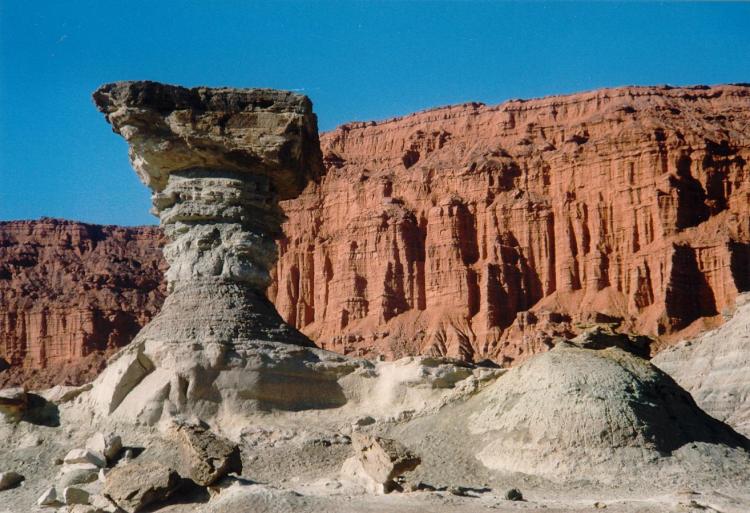
Image from Ischigualasto Park (http://www.ischigualasto.gob.ar/)
Ischigualasto is an arid, sculpted valley, in northwest Argentina (San Juan Province), limiting to the north with the Talampaya National Park, in La Rioja Province. Both areas belong to the same geological formation: the Ischigualasto-Villa Unión Basin which is centered on a rift zone that accumulated thick terrestrial deposits during the Triassic. This basin preserves a complete and continuous fossiliferous succession of continental Triassic rocks.
The Ischigualasto Formation is known worldwide for its tetrapod assemblage, which included the oldest known record of dinosaurs. Adolf Stelzner in 1889 published the first data on the geology of Ischigualasto, but it was not until 1911, that Bondenbender briefly refers to the fossils of the site. Several thin volcanic ash horizons, indicates that the deposition of the Ischigualasto Formation began at the Carnian Stage (approximately 228 mya), and consists of four lithostratigraphic members which in ascending order include the La Peña Member, the Cancha de Bochas Member, the Valle de la Luna Member, and the Quebrada de la Sal Member.

1–3. Retusotriletes herbstii sp. nov; 4–5. Rogalskaisporites cicatricosus; 6. Rugulatisporites
During the Late Triassic two distinct microfloras have been recognised in the southern hemisphere: the Ipswich microflora and the Onslow microflora. The Ipswich province, characterized by the abundance of bisaccate pollen, monosulcate pollen and trilete spores, evolved in southern and eastern Australia, Transantarctic Mountains region, South Africa and Argentina. The Onslow province is a mixture of Gondwanan and European taxa recognized in of north-western Australia, Madagascar, East Africa, Indian, and East Antarctic (Cesari and Colombi; 2013).
The recognition of Carnian European species in the Valle de la Luna Member of the Ishchigualasto Formation expands the distribution of the Onslow-type palynofloras. This assemblage was recovered from the site known as “El Hongo” in the Provincial Park, and contain the diagnostic “Onslow” species: Samaropollenites speciosus, Enzonalasporites vigens, Patinasporites densus, Vallatisporites ignacii, Ovalipollis pseudoalatus and Cycadopites stonei. This assemblage indicates that the Valle de la Luna Member was likely deposited under more humid conditions. It also implies the existence of a latitudinal floral belt from Timor (through the Circum-Mediterranean area) to western Argentina.
References:
Cesari, Silvia N., Colombi, Carina, Palynology of the late Triassic ischigualasto formation, Argentina: Paleoecological and paleogeographic implications, Palaeogeography, Palaeoclimatology, Palaeoecology (2016), doi: 10.1016/j.palaeo.2016.02.023
Césari, S. N., Colombi, C. E., 2013. A new Late Triassic phytogeographical scenario in westernmost Gondwana. Nature communications, 4.
Spalletti, L. A. Artabe, A. E. & Morel, E. M. Geological factors and evolution of southwestern Gondwana Triassic plants. Gondwana Res. 6, 119–134 (2003).





